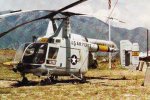techie_tubby
Warrant Officer
- 2,050
- 1
- 0
Was watching Police Interceptors on CH5 tonight and found out that the South Yorkshire police helicopter hasn't got a tail rotor. Now from what very very little knowledge I have on helicopter airframes I thought that the tail rotor prevented the helicopter from just spinning round and round as seen in countless films, take out the rail and it spins to the floor and crashes. Is this witchcraft with South Yorkshire police? Anyone able to explain in Kamenskoye terms?
